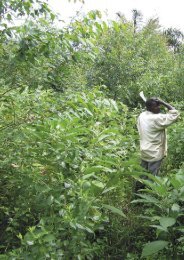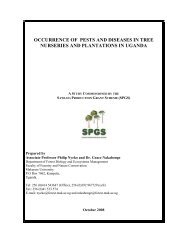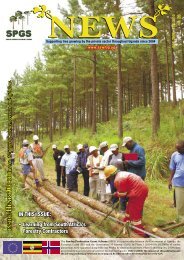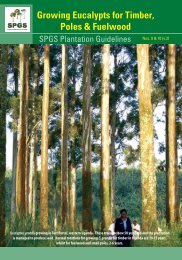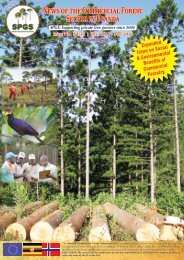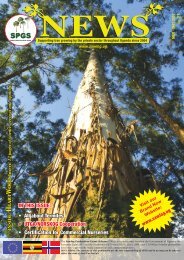download - SPGS
download - SPGS
download - SPGS
You also want an ePaper? Increase the reach of your titles
YUMPU automatically turns print PDFs into web optimized ePapers that Google loves.
HeartWood No. 1 (2009)<br />
training; research and technology<br />
transfer in forest plantations; hence<br />
contributing to the mission of the<br />
Faculty of Forestry and Nature<br />
Conservation and that of Makerere<br />
University. Further, the programme<br />
is well suited in fulfilling MDGs 1<br />
& 7.<br />
The Faculty of Forestry and Nature<br />
Conservation is well endowed with<br />
well trained staff in the different<br />
disciplines, who in collaboration<br />
with staff from other relevant<br />
Faculties will contribute to the<br />
smooth implementation of the<br />
programme. Further, the faculty<br />
has professional and cordial<br />
relationships with Forest Research<br />
Institutes (e.g. NaFORRI),<br />
private commercial tree farmers<br />
(individuals and companies),<br />
National Forestry Authority,<br />
Forest Services Sector Division<br />
and the <strong>SPGS</strong>, which will enhance<br />
knowledge sharing as well as fieldbased<br />
learning.<br />
In addition to the currently<br />
available space for teaching and<br />
learning (office space, specialised<br />
research laboratories, lecture<br />
rooms, computer laboratory<br />
and library), we are currently<br />
discussing with likely partners<br />
willing to commit funds for setting<br />
up a joint resource centre (located<br />
at Makerere University campus)<br />
to serve as one-stop reference<br />
facility for tree farmers, <strong>SPGS</strong> and<br />
Makerere University community.<br />
This facility will greatly enhance<br />
the development and dissemination<br />
of knowledge in reference to<br />
commercial tree farming.<br />
Head, Dept. of Forest Management,<br />
Makerere University.<br />
IMPORTANT PUBLICATIONS.<br />
FAO’s Global Review<br />
of Forest Pests and<br />
Diseases (2009)<br />
FAO’s Global Review of Forest Pests and<br />
Diseases (2009) is a timely publication<br />
for us in Uganda, as we need to plan<br />
now for any potential threats to<br />
growers’ investments.<br />
Measures to protect forests from insect<br />
pests and diseases (P&D) are an important<br />
part of sustainable forest management.<br />
Effective P&D management requires reliable<br />
information on the P&D themselves, including<br />
their biology, ecology, distribution and of<br />
course, possible methods of control. For this<br />
report, FAO coordinated the responses from<br />
25 countries around the world - including 7<br />
African countries – Ghana, Kenya, Malawi,<br />
Mauritius, Morocco, RSA and Sudan.<br />
The report states that most countries do not<br />
carry out routine monitoring and detection<br />
of P&D. It also highlights the lack of trained<br />
people capable of identifying P&D. Reading<br />
the report, it is clear that Africa faces severe<br />
challenges from invasive forest P&D: they<br />
cite the blue gum chalcid (Leptocybe invasa)<br />
– now found from the North to the South of<br />
the African continent. Other P&D introduced<br />
the last five years include:<br />
• Cinara pinivora (giant conifer aphid) in<br />
Malawi.<br />
• Coniothyrium zuluense – Ethiopia.<br />
• Thoumastocoris peregrinus (bronze bug)<br />
and Coryophodema tristis – RSA.<br />
• Gonometa podocarpi – Tanzania.<br />
All the above P&D pose threats to<br />
neighbouring countries. The report lists<br />
other important P&D in Africa as:<br />
• Cupressus cupressivora (cypress aphid).<br />
• Eulachnus rileyi (pine needle aphid).<br />
• Pineus pini (pine woolly aphid).<br />
• Sirex noctilio (European wood wasp).<br />
• Plus a range of cosmopolitan fungi,<br />
including Armillaria spp. (root rot);<br />
Sphaeropsis sapinea (shoot blight) and<br />
Mycoshpaerella pini (red band needle<br />
blight).<br />
The report has sections on selected, transboundary<br />
P&D and also on selected tree<br />
species. Inevitably though, having such<br />
a global scope means that only a limited<br />
selection can be covered in the report<br />
(though the authors do say that the list will<br />
be expanded on their web-site over time).<br />
As with (most of) FAO’s publications, this<br />
one is available free (as a pdf) from their<br />
web-site – www.fao.org/forestry - though it<br />
would be preferable to have higher quality<br />
photographs to be able to identify the pests<br />
better. Presumably one must pay for that!<br />
ENERGY<br />
GROWS ON<br />
TREES<br />
ITTO (2008). Int. Tropical Timber Org.<br />
Technical Series No. 31; 87pp.<br />
Available as a free <strong>download</strong> from<br />
www.itto.org<br />
“The increased interest in<br />
wood-based bio-energy has<br />
been stimulated by two main<br />
concerns: energy security and<br />
climate change”. So says Wulf Killmann<br />
(FAO’s Director of Forest Products and<br />
Industry) in his opening address at this<br />
gathering of very illustrious people.<br />
Energy Grows on Trees is a report from<br />
an international conference on woodbased<br />
bio-energy, held in Hanover,<br />
Germany, in 2007.<br />
The clear message that jumps out at the<br />
reader from the various presentations is<br />
that wood-based bio-energy is a rapidly<br />
developing sector but much of the<br />
technology is in developed countries.<br />
One of the conference’s nine specific<br />
recommendations caught your reviewer’s<br />
eye – namely, to investigate the creation of<br />
small grants schemes of wood-based bioenergy,<br />
especially in tropical countries.<br />
Now there’s an interesting thought!<br />
11



